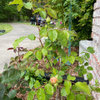Cleanup important if roses have black spot
henry_kuska
10 years ago
Related Stories

BATHROOM DESIGNSpotted: Refrigerators in the Bathroom
You read that right. Before you protest, here are seven good reasons why people are chilling in the bath
Full Story
GARDENING GUIDESWhat Kind of Roses Should You Grow?
Want to add the beauty of roses to your garden? Find out which ones, from old-fashioned to modern, are right for you
Full Story
WINTER GARDENINGPruning Secrets for Exquisite Roses
Encourage gorgeous blooms year after year with this time-tested advice on how to prune your rosebush in winter for health and shape
Full Story
GARDENING GUIDESLearn the Secret to Bigger and Better Roses
Grow beautiful roses using both ordinary and unusual soil amendments
Full Story
PLANTING IDEASGreat Garden Combo: Rose + Clematis for Small-Space Impact
We all need somebody to lean on. And when a rose supports a climbing vine, the results can totally transform a small garden
Full Story
GARDENING GUIDES6 Captivating Roses for an Alluringly Fragrant Garden
Perfume your garden with aromas from richly spicy to lightly sweet, without sacrificing an inch of color
Full Story
LANDSCAPE DESIGNMake Your Roses Even More Beautiful With These Companion Plants
Nourish your rosebushes and create a visual feast with these 7 classic and unexpected plant pairings
Full Story
COLOR11 Reasons to Paint Your Ceiling Black
Mask flaws, trick the eye, create drama ... a black ceiling solves a host of design dilemmas while looking smashing
Full Story
LANDSCAPE DESIGNGet a Knack for Black in the Garden
Dark walls, furniture and foliage do more than add drama in the landscape; they can be strategic design elements
Full Story
WHITERoom of the Day: Bye-Bye, Black Bidet — Hello, Classic Carrara
Neutral-colored materials combine with eclectic accessories to prepare a master bath for resale while adding personal style
Full StoryMore Discussions









michaelg
seil zone 6b MI
Related Professionals
Coeur d'Alene Landscape Contractors · Conroe Landscape Contractors · Davidson Landscape Contractors · Garland Landscape Contractors · Hawthorne Landscape Contractors · Hendersonville Landscape Contractors · Kailua Landscape Contractors · Longmont Landscape Contractors · Monterey Landscape Contractors · Pahrump Landscape Contractors · West Allis Landscape Contractors · West Chester Landscape Contractors · Wilsonville Landscape Contractors · Kingsburg Landscape Contractors · Clearfield Landscape Contractorshenry_kuskaOriginal Author
jim1961 / Central Pennsylvania / Zone 6
rosesinny
anntn6b
henry_kuskaOriginal Author
predfern
michaelg
DisplacedClevelander
susan4952
meredith_e Z7b, Piedmont of NC, 1000' elevation
michaelg
henry_kuskaOriginal Author
michaelg
nickl
henry_kuskaOriginal Author
meredith_e Z7b, Piedmont of NC, 1000' elevation
meredith_e Z7b, Piedmont of NC, 1000' elevation
michaelg
meredith_e Z7b, Piedmont of NC, 1000' elevation
michaelg
elks